I had thought that I’d be writing Part Two of “Steering Rene Right” (correcting the steering issue in my beloved ’73 3.0CSi), but instead of initiating a blitzkrieg of parts orders and a frantic installation, I’ve settled into a rhythm of research and careful camber measurement. I’m sure that I’ll get back to that topic, but there’s a rhythm to these things.
Speaking of rhythm, after that craziness of buying the 2008 Silverado (The Bigger Badder Mouse Warehouse) in July and cleaning the rodent detritus out of it in August, proper vintage BMW-centric rhythms settled in during autumn. In mid-September I drove my 635CSi down to the Vintage. Then I got Rene out of the garage and took her on a 400-mile mini-road trip to Vintage at Saratoga. My wife Maire Anne and I even squeezed in a run to Nantucket (well, to the Hyannis ferry) in Louie, the ’72 2002tii.
It all served as a visceral reminder that these cars are supposed to be fun—and they can be fun if you take the time and effort to enjoy them.
The other natural rhythm that occurs as summer rolls over into autumn is that the importance of the air-conditioned vintage cars is de-emphasized, and the non-a/c cars that have been sitting on the sidelines during the hot months can come out and play. I wrote about re-engaging Zelda, my Z3, which is air-conditioned, but I still haven’t re-installed the compressor belt after the curb-strike incident last year shattered the compressor mount.
My Lotus Europa came out of hiding, too, and in an odd bit of empathy with the giant truck, informed me that it also has a rodent-smell issue (almost certainly an old heater-box odor that blossomed from sitting). Enjoying these cars in the eye-popping New England autumn colors is something precious, and I try to do it as often as I can, even if it’s just taking a cool car to Trader Joe’s to buy a gallon of milk.

Or, in this case, wine, beer, and mayo.
Conspicuously absent from all this seasonal automotive joy was Hampton, the 49,000-mile ’73 2002 I bought from its original owner on Long Island about two years ago. I’d put it on Bring a Trailer back in April, but it didn’t meet reserve, so I took a break from it and put it in one of the storage spaces I have in Fitchburg. Whenever I was out in Fitchburg swapping cars, I did check on Hampton, pulling the cover off and emptying the water from the canister of DampRid.
There’s something about pulling a cover off a car and seeing it sit there, looking at you like a puppy, that makes you feel guilty. So when I saw the announcement that the Nor’East 02ers autumn gathering and drive was set for a Saturday at the end of October, the tumblers in my brain turned and clicked into place: I was suddenly hell-bound and determined to get Hampton out in the sun and let him mix it up with his 2002 brothers and sisters. I ran out to Fitchburg in Louie, the ’72 2002tii, and swapped him for Hampton.
Initially, it did not go well; Hampton refused to start.
But I expected that. It’s been a recurring problem: After the car has been sitting, it takes forever to fill the float bowl of the Weber. So either the mechanical fuel pump is weak, or there’s a pinhole leak in one of the fuel lines. When I drove out there, I took a little electric fuel pump with me, temporarily spliced it in place instead of the mechanical pump, and ran it until I could hear the rapping sound of its internal solenoid change as it pumped against the pressure of the now-closed needle valve. The car then started easily.
As I motored the tidy little Chamonix 2002 down Route 2 and back to Newton, I had two conflicting feelings:
- Much of owning a car, particularly a vintage car, is simply occupying its interior real estate, and from that standpoint, driving Hampton is pretty damn nice. Its dead-stock interior is in just about the best survivor shape you could ever expect to see.
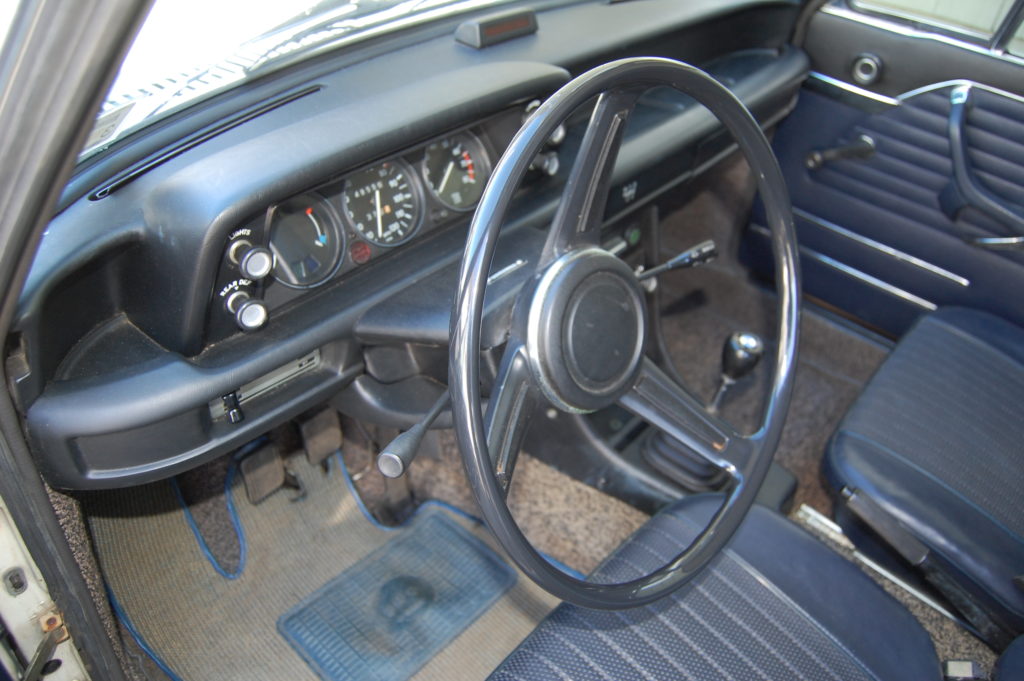
How could you not love driving this?
- While there’s zero question that Hampton is by far the nicest of my three 2002s, driving-wise, it’s as boring as Cream of Wheat compared with Louie and Bertha, the former track rat. Acceleration is laughably slow, and the car’s original shocks and struts make the suspension so soft that I almost felt seasick driving it. Plus, the fact that I was still driving on the twenty-year-old off-brand flat-spotted skinny 165-section tires that were on the car when I bought it bordered on the indefensible. I justified it because I didn’t think that there was much risk in running back and forth to Fitchburg (50 miles at 60 mph on fairly straight roads) and because I thought the choice of rubber was better left to the next owner—but there is a line of sanity with regard to old tires, and I was veering across it.
When I got home, I bounced the car on all four corners. The rear shocks were functional but extremely soft, and the fronts felt a little schizophrenic. The right front strut simply felt mush-soft like the rears, but the left front felt like it was blown (e.g., that corner just bounced without any damping) until I bounced it enough times that it firmed up to the point where it almost seemed like it was sticking.
So I hatched a little plan: Hampton was going to get new tires and new shocks and struts. And I was going to install them in time for the Nor’East 02er autumn drive.
For the tires, I went with a set of Achilles 122 185/70-13s. Despite the unfortunate brand name (“If only we knew that these tires had some sort of weakness…”), they’re inexpensive, I have them on a few cars including my E39, and I like them. And in the little thirteen-inch size, they’re dirt cheap; I found a tire shop selling sets of four on eBay for $210 shipped. That brought the cost, with mounting and balancing, to under $300.
Hey, you can make your choices and I can make mine, but to me, this was perfect. I’d get new tires that I’d feel safe on (and wouldn’t need to continue my ridiculous justification of why it was okay to keep driving on the twenty-year-old Caliente tires—now, there’s a brand with strong owner loyalty—that dated back nearly to the Clinton administration), and they were cheap enough that if I did sell the car, the new owner could do whatever he or she wanted with them, including throw them in the municipal recycling bin.
For the shocks and struts, the go-to for any vintage BMW are the Bilstein heavy-duty (HD) units, but at this point they’ve been back-ordered for years. Used sets show up on eBay, but they get snatched up quickly. So imagine my delight when I jumped on eBay and saw a set of Bilstein HD shocks and another set of HD struts, from two different sellers, both with very reasonable Buy It Now prices. I checked the part numbers, made sure that they were HDs and not the sport version, punched the Buy It Now button, and smiled at my good fortune. (These days, Bilstein branding has replaced with HD with Performance, and Sport with Performance Plus.) Hot damn: new shoes and suspenders. Hampton was going to get downright pimped for the Nor’Easter autumndrive.
Unfortunately, none of it worked out that way.
Once I received tracking numbers, it was clear that the tires would arrive too late. That wasn’t a show-stopper, however, because I had the tii steel wheels and recent Kumho tires from Louie (who was now wearing fourteen-inch E30 steelies) sitting in the basement gathering dust. I threw them on Hampton. Why I didn’t do this a year ago is beyond me.
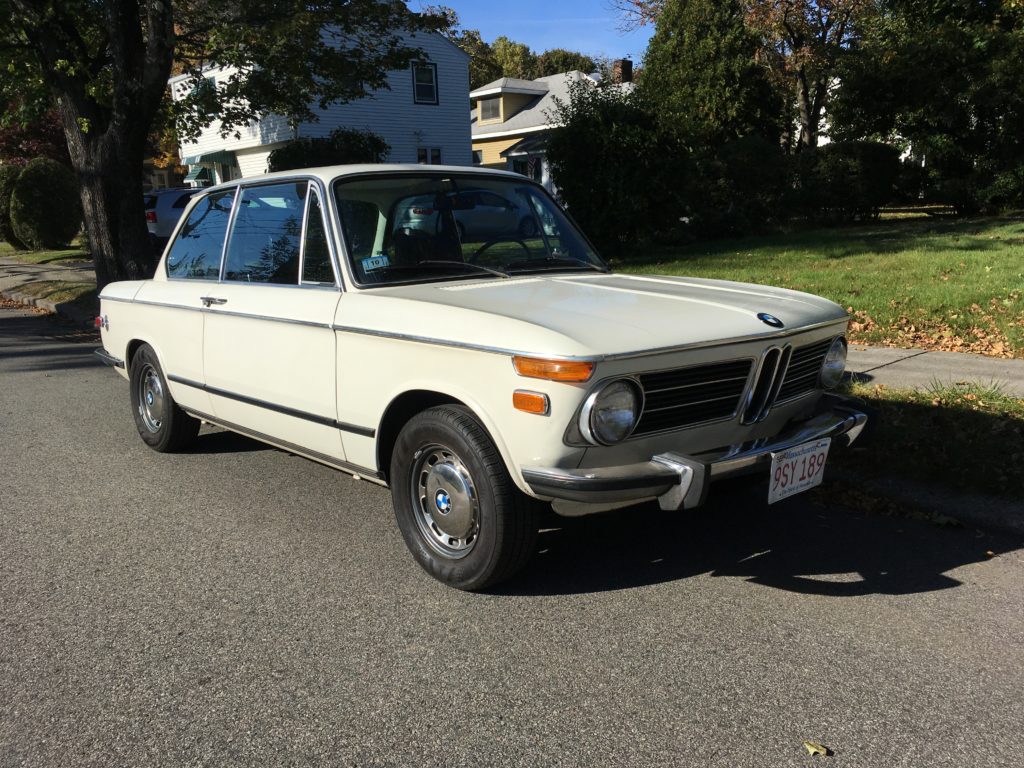
Hampton temporarily wears the five-inch-wide wheels from Louie, which I leave painted gray just because I know how much it bugs my friend Paul Wegweiser.
The shocks and struts were slated to arrive Friday; it would be tight but not impossible to get them installed in time for a Saturday-morning drive. It depended on when they arrived, my level of energy, and how much went wrong during the installation. By chance, the two separate deliveries of used Bilstein HD shocks and struts arrived around noon on Friday.
I dived right in.
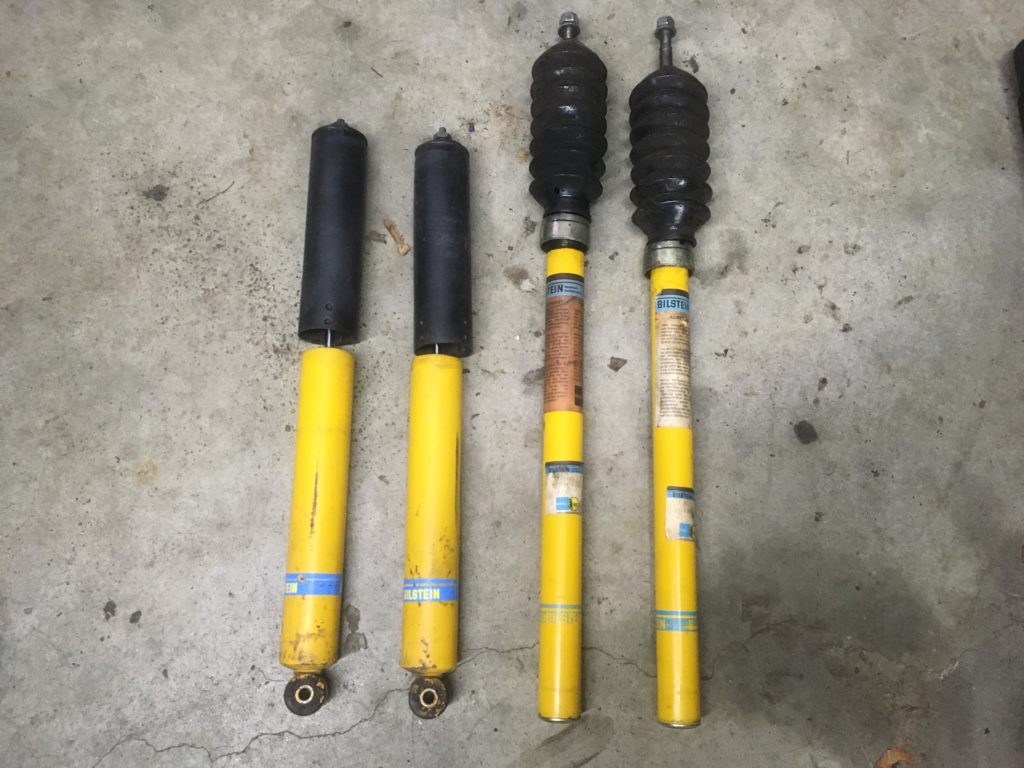
Even used, yum.
Shocks are trivial to install: Jack up the car, set it on stands, pull the wheels, undo the 19-mm nut holding the shock to the bottom stud, bang it off with a rubber mallet, undo the two 14-mm lock nuts at the top, drop the old shock out, install the new one, repeat on the other side, boom, done. I had the new/used rear Bilsteins done in about 40 minutes.
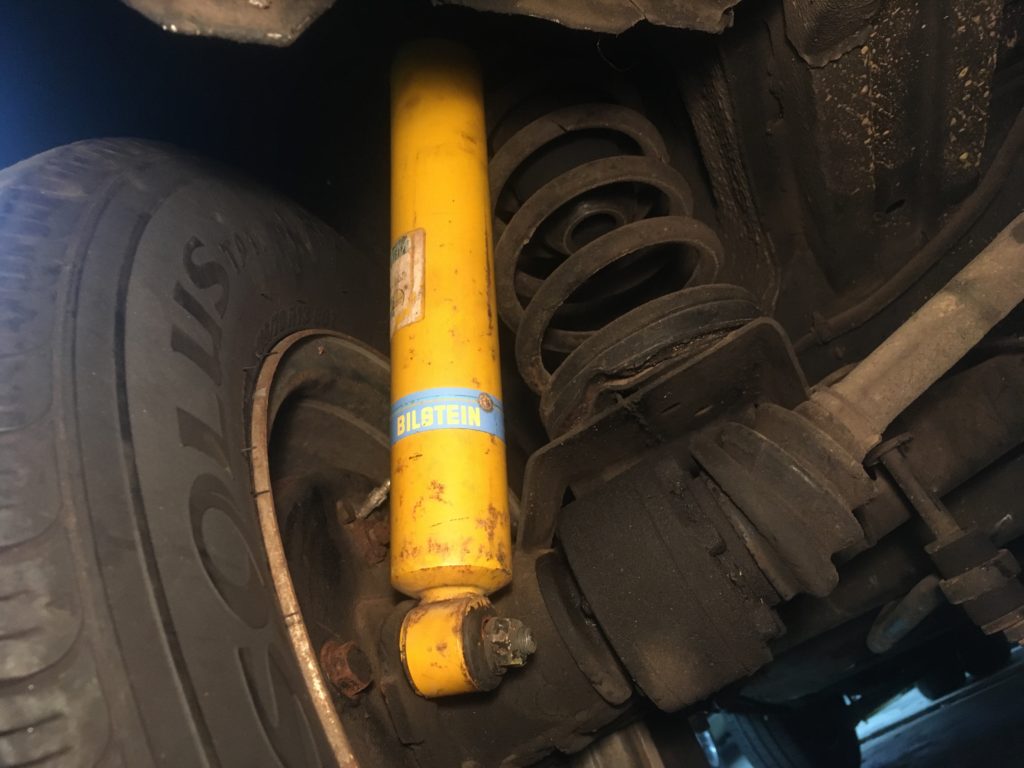
The used Bilstein shocks looked completely in keeping with Hampton’s survivor undercarriage.
Struts, on the other hand, are substantially more involved, since the strut assembly has to be removed from the car, and the spring has to be compressed and then removed to access the collar nut securing the strut cartridge. Before I attacked the struts, I made myself some lunch, sat down at the computer while eating it, checked my email, and learned that the Nor’East 02er autumn drive had been cancelled due to an approaching—oh, the irony!—nor’easter that was predicted to dump buckets of rain. And with that, my idea of Hampton’s frolicking in the autumn leaves with his 2002 pals was dashed, the appealing image scattering like those leaves.
Damn.
But hey, I still had struts to install. I won’t go into the details here, as I wrote about the nuts-and-bolts of Hampton’s strut replacement in mind-numbing detail here on bmw2002faq.com. No bolts were seized, and I found that I could reuse the rubber perch and tower bushings, meaning that there were no additional parts to order. Working at a leisurely pace, by the end of Saturday, I had it knocked out.
I’ve sometimes repeated the cliché that I did X and Y and it “transformed the car,” and sometimes that’s true. Here, it wasn’t; this was shocks and struts only. When I refreshed the suspension in Louie early in the summer, I did it all—Bilstein HDs and H&R Sport progressive-rate springs and Suspension Techniques sway bars—thus not only stiffening the dampers, but also lowering the car a little, changing the suspension characteristics, and knocking the body roll way down. That really did “transform the car.”
Here, not so much. It doesn’t make me want to downshift, nail the throttle, and throw it into entrance ramps as it did with Louie. What’s different, though, is that with the mashed-potato-soft shocks and struts gone, I no longer get that seasick feeling on undulating terrain. I do wish that the car was a little lower and not showing as much wheel well above the tires (gas-pressurized shocks like the Bilsteins will sometimes make a car sit slightly higher), but that’s what you get for sticking with stock springs.
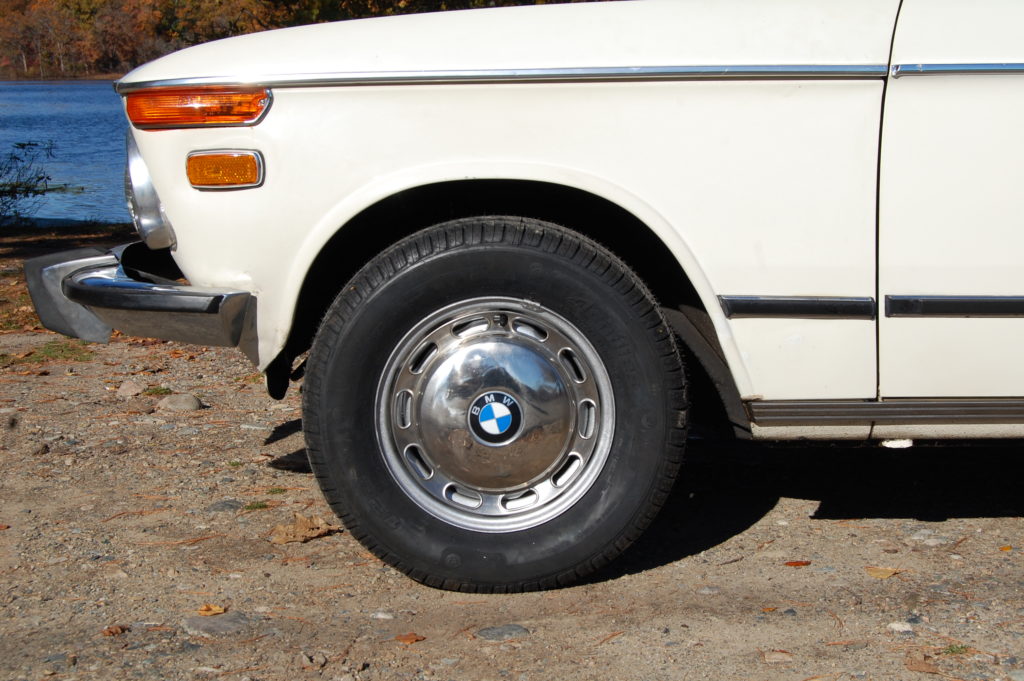
It’s firmer, but certainly not lower.
On the tire side of things, with fresh rubber on the wheels, the car isn’t whispering to me to find the limits of adhesion and hang its tail out, but I can now let the highway speed creep up to 75 or 80 without feeling like I’m engaging in blatantly risky behavior. And of course with what had been a mushy suspension and crap tires replaced with something crisp, there’s now the next layer of the onion, which is that the car feels a little out of alignment—but still, a happy problem to have.
So: Hampton has found an unexpected place in the autumn palette. He may still be softer and slower than the other two 2002s, but hey, that Chamonix paint totally works with the foliage. I am a practical man.—Rob Siegel
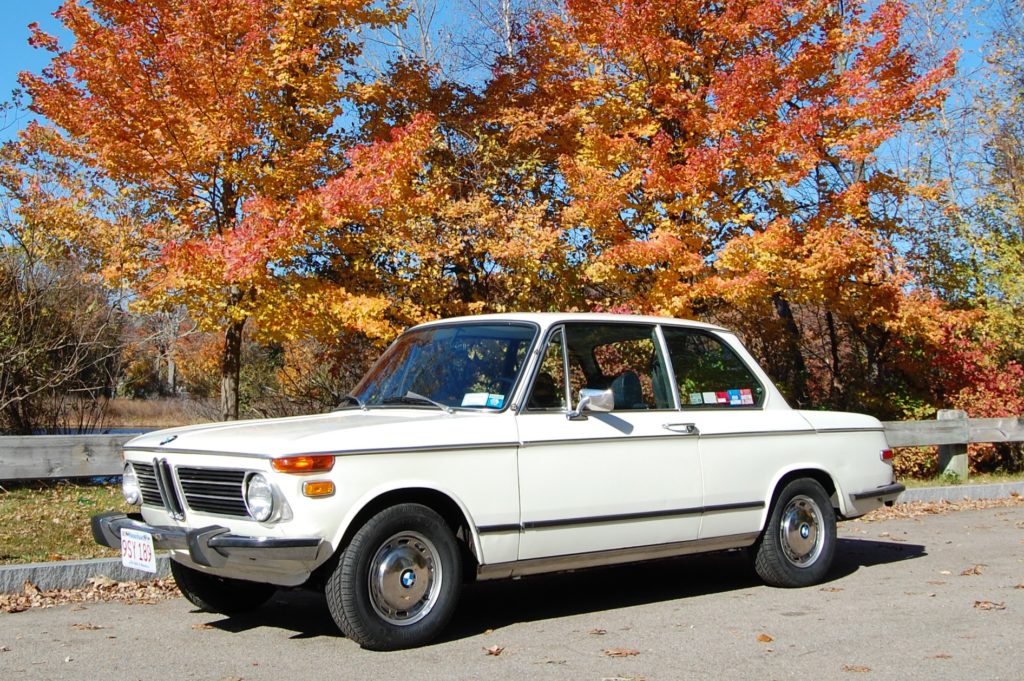
Rob’s new book, The Best of The Hack Mechanic, is available here on Amazon, as are his seven other books. Signed and personally-inscribed copies can be ordered directly from Rob here.





















